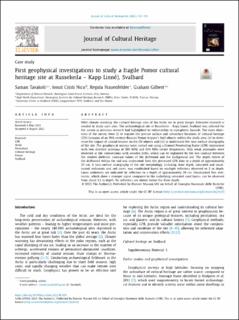| dc.contributor.author | Tavakoli, Saman | |
| dc.contributor.author | Nicu, Ionut Cristi | |
| dc.contributor.author | Frauenfelder, Regula | |
| dc.contributor.author | Gilbert, Graham L. | |
| dc.date.accessioned | 2023-08-17T08:59:59Z | |
| dc.date.available | 2023-08-17T08:59:59Z | |
| dc.date.created | 2023-08-15T08:40:38Z | |
| dc.date.issued | 2023 | |
| dc.identifier.citation | Journal of Cultural Heritage. 2023, 63 187-193. | |
| dc.identifier.issn | 1296-2074 | |
| dc.identifier.uri | https://hdl.handle.net/11250/3084523 | |
| dc.description.abstract | With climate warming, the cultural heritage sites of the Arctic are in great danger. Extensive research is needed to study such sites. The archaeological site at Russekeila – Kapp Linné, Svalbard was selected for the survey as previous research had highlighted its vulnerability to cryospheric hazards. The main objectives of the survey were (i) to register the precise surface and subsurface locations of cultural heritage (CH) (remains of an 18th century Russian Pomor trapper's hut) objects within the study area, (ii) to determine the impact of coastal erosion on the CH objects and (iii) to understand the near-surface stratigraphy of the site. The geophysical surveys were carried out using a Ground Penetrating Radar (GPR) instrument with two shielded antennas of 500 MHz and 800 MHz centre frequencies. Only weak anomalies were observed at the intersections with wooden drifts, which can be explained by the low contrast between the relative dielectric constant values of the driftwood and the background soil. The depth extent of the driftwood within the soil was understood from the processed GPR data to a depth of approximately 25 cm. A near-surface stratigraphy of the site morphology, including thaw depth, saturated and unsaturated sediments and soil cover, was established based on multiple reflectors observed to 2 m depth. Loose sediments are indicated by reflectors to a depth of approximately 20 cm. Unsaturated fine sediments, which show a stronger signal compared to the underlying saturated sand layers, can be observed from about 1.2 m depth. No reflectors are shown below the thaw depth. | |
| dc.description.abstract | First geophysical investigations to study a fragile Pomor cultural heritage site at Russekeila – Kapp Linné), Svalbard | |
| dc.language.iso | eng | |
| dc.title | First geophysical investigations to study a fragile Pomor cultural heritage site at Russekeila – Kapp Linné), Svalbard | |
| dc.title.alternative | First geophysical investigations to study a fragile Pomor cultural heritage site at Russekeila – Kapp Linné), Svalbard | |
| dc.type | Peer reviewed | |
| dc.type | Journal article | |
| dc.description.version | publishedVersion | |
| dc.source.pagenumber | 187-193 | |
| dc.source.volume | 63 | |
| dc.source.journal | Journal of Cultural Heritage | |
| dc.identifier.doi | 10.1016/j.culher.2023.08.005 | |
| dc.identifier.cristin | 2166936 | |
| dc.relation.project | Norges forskningsråd: 294314 | |
| dc.relation.project | Norges forskningsråd: 333192 | |
| cristin.ispublished | true | |
| cristin.fulltext | original | |
| cristin.qualitycode | 2 | |
